List of old-growth forests
This is a list of existing old-growth ("virgin") forests, or remnants of forest, of at least 10 acres (4.0 hectares). Ecoregion information from "Terrestrial Ecoregions of the World".[1]
(NB: The terms "old growth" and "virgin" may have various definitions and meanings throughout the world. See old-growth forest for more information.)
Africa
| Country | Area | Old-growth extent | WWF ecoregion | Old-growth forest type |
|---|---|---|---|---|
| Réunion (France) | Réserve biologique intégrale du Bois des Nèfles | 179 hectares (440 acres) | Tropical and subtropical dry broadleaf forests | |
| Réunion (France) | Réserve biologique intégrale du Piton de la Fournaise | 21,005 hectares (51,900 acres) | Tropical and subtropical moist broadleaf forests | |
| Réunion (France) | Réserve biologique intégrale du Mazerin | 2,491 hectares (6,160 acres) | Tropical and subtropical dry broadleaf forests | Pandanus scrub |
| Kenya | Kakamega Forest |
Australia
In Australia, the 1992 National Forest Policy Statement (NFPS) made specific provision for the protection of old growth forests. The NFPS initiated a process for undertaking assessments of forests for conservation values, including old growth values. A working group of state and Australian Government agencies took the NFPS definition into consideration in developing a definition that was accepted by all governments (JANIS 1997).[2]
| “ | Old growth forest is ecologically mature forest where the effects of disturbances are now negligible. | ” | |
| — JANIS 1997 | |||
In 2008, only a relatively small area (15%) of Australia's forests (mostly tall, wet forests) had been assessed for old-growth values.[3]
Of the 23 million hectares (57 million acres) of forest in Australia assessed for their old-growth status, 5 million hectares (12 million acres) (22%) is classified as old-growth.[4] Almost half of Australia's identified old-growth forest is in NSW, mostly on public land.[3] More than 73% of Australia's identified old-growth forests are in formal or informal nature conservation reserves.[4]
In 2001, Western Australia became the first state in Australia to cease logging in old-growth forests.[5]

| Country | Area | Old-growth extent | WWF ecoregion | Old-growth forest type |
|---|---|---|---|---|
| Australia | Walpole Wilderness Area | Jarrah-Karri forest and shrublands | Karri, Jarrah, Eucalyptus jacksonii, Eucalyptus guilfoylei | |
| Australia | Barrington Tops National Park, New South Wales | Eastern Australian temperate forests | subtropical and temperate rainforest and eucalypt | |
| Australia | Greater Blue Mountains Area, New South Wales | Eastern Australian temperate forests | eucalypt forest | |
| Australia | Tarkine, Tasmania | 2,000 square kilometres (770 sq mi) | Tasmanian temperate rain forests | Temperate rainforest |
| Australia | Tasmanian Wilderness | Tasmanian temperate rain forests | temperate rainforest and eucalypt forest | |
| Australia | Goolengook, East Gippsland, Victoria | Over 20 square kilometres (7.7 sq mi) | Eastern Australian temperate forests | rare warm temperate/cool temperate "Overlap Rainforest" |
| Australia | Blue Tier, Tasmania | 100 hectares (250 acres)[6] | Tasmanian temperate rain forests | myrtle canopy, unusually diverse understorey for temperate rainforest (celery top pine, waratah, sassafras, tree fern), threatened Simson's Stag Beetle. |
| Australia | Styx Forest, Tasmania | Tasmanian temperate rain forests | ||
| Australia | Weld, Tasmania | Tasmanian temperate rain forests | ||
| Australia | Upper Florentine Valley, Tasmania | Tasmanian temperate rain forests | ||
| Australia | Badja State Forest, New South Wales[7] | Eastern Australian temperate forests | Wet old-growth with sweeping tree-fern understoreys. 10+ threatened species (including squirrel glider and golden-tipped bat) | |
| Australia | Dampier State Forest, New South Wales[7] | Eastern Australian temperate forests | Wet old-growth. Most extensive rainforests in the South Coast. | |
| Australia | Wandella / Peak Alone, New South Wales[7] | Eastern Australian temperate forests | High old-growth and threatened species values. Important catchment value. | |
| Australia | Monga State Forest / Buckenbowra, New South Wales[7] | Eastern Australian temperate forests | Pristine Buckenbowra River, including an area on the northern side of the river with a golden-tipped bat record. Also an area around McGregors Creek, nominated for wilderness, and important for old-growth and to increase the viability of the connection / link between Buckenbowra and Deua National Park. | |
| Australia | Dampier, New South Wales[7] | Eastern Australian temperate forests | Upper Deua River (Identified Wilderness) and Big Belimba Creek catchment and contains extensive old-growth forests. Big Belimba Creek contains giant wet old-growth forest and extensive tree-fern forests. | |
| Australia | Tallaganda State Forest, New South Wales[7] | Eastern Australian temperate forests | Tall wet old-growth forest. | |
| Australia | Gondwana Rainforests of Australia | 50 separate reserves totaling 366,500 hectares (906,000 acres) | Subtropical rainforest | The most extensive area of subtropical rainforest in the world. Extremely high conservation value; over 200 rare or threatened plant and animal species. |
The term "old-growth forests" is rarely used in New Zealand, instead, "The Bush" is used to refer to native forests. There are large contiguous areas of forest cover that are protected areas.
Eurasia
North America
Canada
United States
Central America
| Country | Area | Old-growth extent | WWF ecoregion | Old-growth forest type |
|---|---|---|---|---|
| Costa Rica | Braulio Carrillo National Park | 428 square kilometres (165 sq mi) | Talamancan montane and Isthmian-Atlantic moist forests | |
| Panama | Chagres National Park | 428 square kilometres (165 sq mi) | coastal tropical |
South America
| Country | Area | Old-growth extent | WWF ecoregion | Old-growth forest type |
| French Guiana(France) | Réserve biologique intégrale de Lucifer Dékou-Dékou | 64,373 hectares (159,070 acres) | Tropical and subtropical moist broadleaf forests | Tropical rainforest |
See also
Notes
- ↑ Olson, D. M, E. Dinerstein; et al. (2001). "Terrestrial Ecoregions of the World: A New Map of Life on Earth". BioScience. 51 (11): 933–938. doi:10.1641/0006-3568(2001)051[0933:TEOTWA]2.0.CO;2.
- ↑ Rodney J. Keenan; Michael F. Ryan. "Science for Decision Makers - Old Growth Forest in Australia: Conservation status and significance for timber production" (PDF). Bureau of Rural Sciences.
- 1 2 Adam Gerrand; Tim Clancy; Stuart Davey; Geoff Dunn; Ian Frakes (2008). "Old-growth forest areas and their reservation status across Australia" (PDF). Bureau of Rural Sciences.
- 1 2 "Australia's State of the Forests Report 2013" (PDF). Australian Bureau of Agricultural and Resource Economics and Sciences. 2013.
- ↑ "Protecting Old-Growth Forests". Forest Products Commission, Government of Western Australia.
- ↑ "Blue Tier Reserve Report 2015". 2015.
- 1 2 3 4 5 6 "NSW South Coast Forests - Revised List of Icon Areas under Threat". Wilderness Society. 2015.
- ↑ "Hyrcanian Forest (Caspian Forest)".
- 1 2 3 4 5 6 7 8 9 10 11 12 13 14 "Protected Areas". Nova Scotia Environment. Retrieved 2008-12-27.
- ↑ "Organisme" (in French). Regroupement du Bois Beckett. Retrieved 13 August 2014.
- 1 2 3 4 5 6 7 8 9 10 11 12 13 14 15 16 17 18 19 20 21 22 23 24 25 26 27 28 29 30 31 32 33 34 35 36 37 38 39 40 41 42 43 44 45 46 47 48 49 50 51 52 53 54 55 56 57 58 59 60 61 62 63 64 65 66 67 68 69 70 71 72 73 74 75 76 77 78 79 80 81 82 83 84 85 86 87 88 89 90 91 92 93 94 95 96 97 98 99 100 101 102 103 104 105 106 107 108 109 110 111 112 113 114 115 116 117 118 119 120 121 122 123 124 125 126 127 128 129 130 131 132 133 134 135 136 137 138 139 140 141 142 143 144 145 146 147 148 149 150 151 152 153 154 155 156 157 158 159 160 161 162 163 164 165 166 167 168 169 170 171 172 173 174 175 176 177 178 179 180 181 182 183 184 185 186 187 188 189 190 191 192 193 194 195 196 197 198 199 200 201 202 203 204 205 206 207 208 209 210 211 212 213 214 215 216 217 218 219 220 221 222 223 224 225 226 227 228 229 230 231 232 233 234 235 236 237 238 239 240 241 242 243 244 245 246 247 248 249 250 Davis, Mary Byrd (10 October 2010). "Old Growth in the East: A Survey". Archived from the original on 25 May 2011.
- ↑ Tongass Forest Management FAQs (accessed 2008-09-18).
- 1 2 3 "Final Environmental Impact Statement for the Revised Land and Resource Management Plan. Ozark-St. Francis National Forests". United States Forest Service Southern Region. 2005. Final Environmental Impact Statement, p. 365
- 1 2 3 4 5 6 7 8 9 10 11 12 13 14 15 16 17 18 19 20 21 22 23 24 25 26 27 28 29 30 31 32 33 34 35 36 37 38 39 40 41 42 43 44 45 46 47 48 49 50 51 52 53 54 55 56 57 58 59 Bolsinger, Charles L.; Waddell, Karen L. (1993), Area of old-growth forests in California, Oregon, and Washington (PDF), United States Forest Service, Pacific Northwest Research Station, Resource Bulletin PNW-RB-197
- 1 2 "Frequently Asked Questions". National Park Service. August 17, 2008. Retrieved 2008-11-15.
- 1 2 Headwaters Forest Reserve 2007 BLM Manager Report
- 1 2 Stahle, David. "Ancient Blue Oak Woodlands of California". University of Arkansas Tree-Ring Laboratory. Retrieved 2008-11-10.
- 1 2 3 4 5 6 7 8 9 10 11 12 13 14 15 16 17 18 19 20 21 22 23 24 25 26 27 28 29 30 31 32 33 34 35 36 37 38 39 40 41 42 43 44 45 46 47 48 Warbington, Ralph; Beardsley, Debby (2002), 2002 Estimates of Old Growth Forests on the 18 National Forests of the Pacific Southwest Region, United States Forest Service, Pacific Southwest Region
- 1 2 3 Rebertus, Alan J.; Thomas T. Veblen; Lynn M. Roovers; Joy Nystrom Mast (1992). "Structure and Dynamics of Old-Growth Englemann Spruce-Subalpine Fir in Colorado". In Merrill R. Kaufmann; William H. Moir; Richard L. Bassett. Old-growth forests in the Southwest and Rocky Mountain regions. General Technical Report RM-213. Rocky Mountain Forest and Range Experiment Station, Forest Service, U.S. Dept. of Agriculture. pp. 139–153. OCLC 26835406.
- 1 2 3 4 5 United States Department of Agriculture Forest Service (February 2008). "Old Growth Chattahoochee-Oconee National Forests, Georgia". Retrieved 2011-02-15.
- 1 2 3 The Nature Conservancy. "The Nature Conservancy in Indiana – Douglas Woods". Retrieved 2009-07-14.
- 1 2 "Pioneer Mothers Memorial Forest Trail".
- 1 2 3 "Ginn Woods - Ball State University". bsu.edu. Ball State University. Retrieved 21 February 2016.
- ↑ Higgins, Will (6 November 2014). "Take 1st look at weird Indiana woods". indystar.com. The Indianapolis Star. Retrieved 21 February 2016.
- 1 2 "Bicentennial Woods - The Nature Conservancy". nature.org. The Nature Conservancy. Retrieved 21 February 2016.
- 1 2 3 DeGroot, Bob (January 12, 2006), "Legislative Issue: Protecting Maryland's Forests and Wildlife", Chesapeake: The Sierra Club Maryland Chapter Newsletter Online
- 1 2 3 Maryland Native Plant Society: Crabtree Old-Growth Forest, Garrett County, Maryland
- ↑ Abrams, Marc, The dendroecology and climatic impacts for old-growth white pine and hemlock on the extreme slopes of the Berkshire Hills, Massachusetts, U.S.A.
- ↑ Hartwick Pines State Park, Visitors Center & Logging Museum
- 1 2 3 "Sheldrick Forest Preserve". The Nature Conservancy. Retrieved 2009-01-02.
- ↑ "Research Natural Area: The Bowl". Northern Research Station. Retrieved 1 October 2015.
- 1 2 Johnson, James A. (1 May 2004). "Enchanted Forest". Retrieved 2009-01-01.
- 1 2 "Old growth forest in Nashville saved".
References
- Davis, Mary Byrd (1996). Eastern Old-Growth Forests: Prospects For Rediscovery And Recovery. Island Press. ISBN 978-1-55963-409-0.
- Eifert, Larry (2000). Field Guide to Old-Growth Forests: Exploring Ancient Forest Ecosystems from California to the Pacific Northwest. Sasquatch Books. ISBN 978-1-57061-234-3.
- "Redwood National Park Frequently Asked Questions". U.S. National Park Service. Retrieved 2008-01-17.
- "Saddler's Woods". Saddler's Woods Conservation Association. Retrieved 2008-01-17.
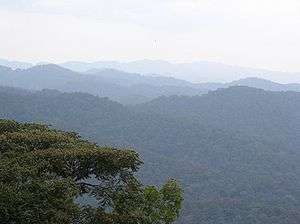

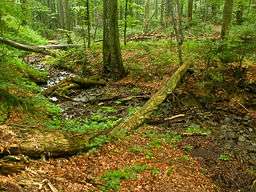



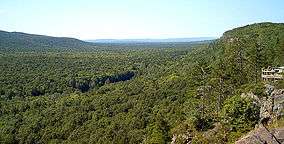

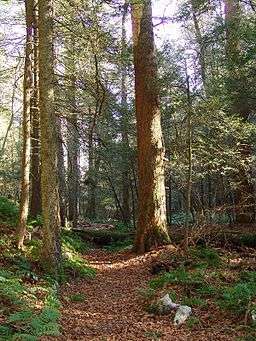
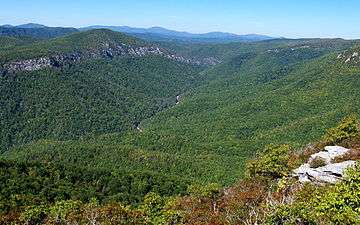
_on_Congaree_National_Park_Low_Boardwalk_trail.jpg)

